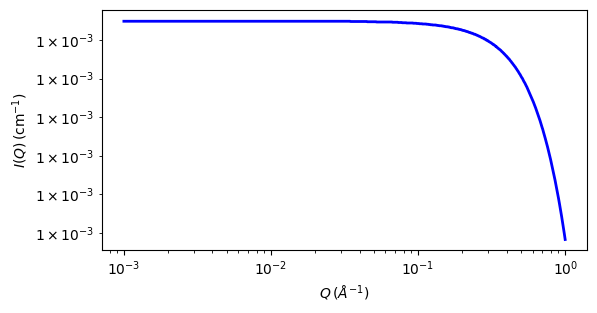rpa¶
Random Phase Approximation
Parameter |
Description |
Units |
Default value |
|---|---|---|---|
scale |
Scale factor or Volume fraction |
None |
1 |
background |
Source background |
cm-1 |
0.001 |
case_num |
Component organization |
None |
1 |
N[4] |
Degree of polymerization |
None |
1000 |
Phi[4] |
volume fraction |
None |
0.25 |
v[4] |
molar volume |
mL/mol |
100 |
L[4] |
scattering length |
fm |
10 |
b[4] |
segment length |
Å |
5 |
K12 |
A:B interaction parameter |
None |
-0.0004 |
K13 |
A:C interaction parameter |
None |
-0.0004 |
K14 |
A:D interaction parameter |
None |
-0.0004 |
K23 |
B:C interaction parameter |
None |
-0.0004 |
K24 |
B:D interaction parameter |
None |
-0.0004 |
K34 |
C:D interaction parameter |
None |
-0.0004 |
The returned value is scaled to units of cm-1 sr-1, absolute scale.
Warning
This model is not functioning correctly in SasView and it appears it has not done so for some time. Whilst the problem is investigated, a workaround for Case 0 below (the most common use case) is to use the binary_blend model available on the Model Maketplace . For further information, please email help@sasview.org . The SasView Developers. February 2022.
Definition
Calculates the macroscopic scattering intensity for a multi-component homogeneous mixture of polymers using the Random Phase Approximation. This general formalism contains 10 specific cases
Case 0: C/D binary mixture of homopolymers
Case 1: C-D diblock copolymer
Case 2: B/C/D ternary mixture of homopolymers
Case 3: C/C-D mixture of a homopolymer B and a diblock copolymer C-D
Case 4: B-C-D triblock copolymer
Case 5: A/B/C/D quaternary mixture of homopolymers
Case 6: A/B/C-D mixture of two homopolymers A/B and a diblock C-D
Case 7: A/B-C-D mixture of a homopolymer A and a triblock B-C-D
Case 8: A-B/C-D mixture of two diblock copolymers A-B and C-D
Case 9: A-B-C-D tetra-block copolymer
Note
These case numbers are different from those in the NIST SANS package!
The models are based on the papers by Akcasu et al. [1] and by Hammouda [2] assuming the polymer follows Gaussian statistics such that \(R_g^2 = n b^2/6\) where \(b\) is the statistical segment length and \(n\) is the number of statistical segment lengths. A nice tutorial on how these are constructed and implemented can be found in chapters 28, 31 and 34, and Part H, of Hammouda’s ‘SANS Toolbox’ [3].
In brief, the macroscopic cross sections are derived from the general forms for homopolymer scattering and the multiblock cross-terms while the inter, polymer cross terms are described in the usual way by the \(\chi\) parameter.
USAGE NOTES:
Only one case can be used at any one time.
The RPA (mean field) formalism only applies only when the multicomponent polymer mixture is in the homogeneous mixed-phase region.
Component D is assumed to be the “background” component (ie, all contrasts are calculated with respect to component D). So the scattering contrast for a C/D blend \(\rho_{C/D} = [\rho_C - \rho_D]\)2.
Depending on which case is being used, the number of fitting parameters can vary.
Note
In general the degrees of polymerization, the volume fractions, the molar volumes, and the neutron scattering lengths for each component are obtained from other methods and held fixed while The scale parameter should be held equal to unity.
The variables are normally the segment lengths (\(b_a\), \(b_b\), etc.) and \(\chi\) parameters (\(K_{ab}\), \(K_{ac}\), etc).

Fig. 121 1D plot corresponding to the default parameters of the model.¶
Source
References
A Z Akcasu, R Klein and B Hammouda, Macromolecules, 26 (1993) 4136
Hammouda, Advances in Polymer Science 106 (1993) 87
B. Hammouda, SANS Toolbox https://www.ncnr.nist.gov/staff/hammouda/the_sans_toolbox.pdf.
Authorship and Verification
Author: Boualem Hammouda - NIST IGOR/DANSE Date: pre 2010
Converted to sasmodels by: Paul Kienzle Date: July 18, 2016
Last Modified by: Paul Butler Date: March 12, 2017
Last Reviewed by: Steve King Date: March 27, 2019